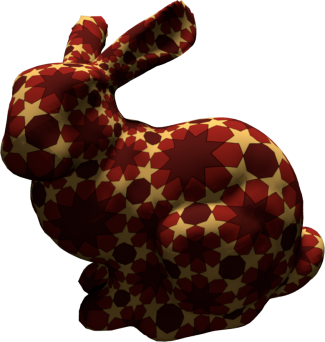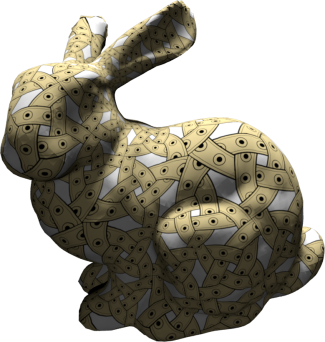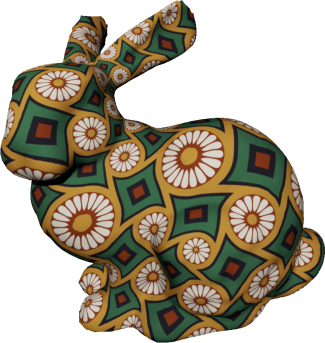Patterns on surfaces

This work comes from ideas I originally had in the late 90s, but was only recently able to carry out based on advances in mesh parameterization. In Pattern-based texturing revisited (Neyret and Cani, SIGGRAPH 1999), the authors create a subdivision of a mesh surface into coarse triangles, and map triangular texture swatches into each of the triangles to produce an overall non-repeating texturing. Many subsequent papers explored the use of coarse mesh parameterization to support non-repeating texturing. For some reason, nobody ever demonstrated the opposite extreme, covering a mesh with a highly repetitive pattern.
This work shows that given a planar pattern belonging to one of five common symmetry groups, it is possible to cover a suitably-parameterized mesh surface with an analogous pattern. The re-interpreted pattern isn't exactly the same -- some concession must be made at the vertices of the coarse parameterization to account for varying curvature. But it's clearly a close relative.
I use the triangles from Globally smooth parameterization for groups p6 and p6m, and the squares from Spectral surface quadrangulation for groups p4, p4g and p4m. Given meshes parameterized using these methods, there's really no work left to do; the rest is just texture mapping.
Gallery
Here is a bunch of additional bunnies rendered with different patterns (don't worry, the paper includes a few other models too). Click on any image to see a larger version.

|

|

|

|

|

|
Texture Samples
In the process of preparing this paper, I re-created several of the designs from Grammar of Ornament as vector drawings in in Adobe Illustrator. I believe that these might be useful for future work in graphics and ornamental design, and so I'm offering the vector files here for general use. The contents of these files are available under a Creative Commons Attribution-Noncommercial-Share Alike license. For practical purposes, that means you can go ahead and use them in your research, as long as you acknowledge me in your paper.
It should be easy to use the data in these files in tools such as Illustrator and Inkscape. If you encounter difficulties, let me know and I might be able to give you the files in some other more suitable format.
Papers
- Semiregular patterns on surfaces. NPAR 2009.